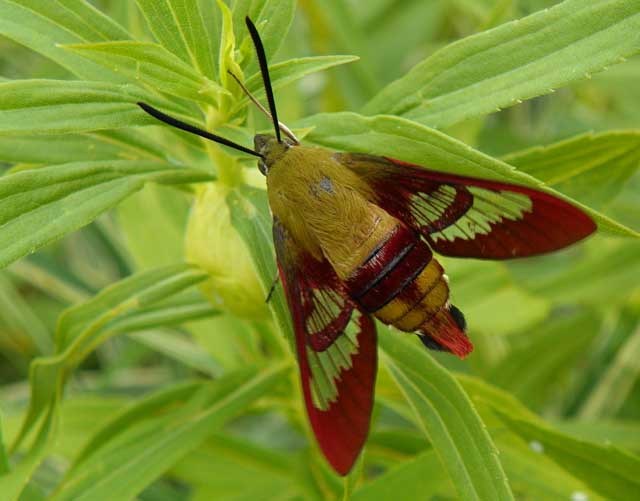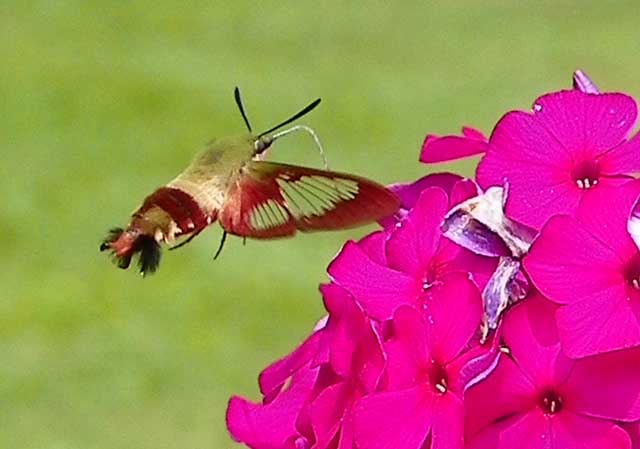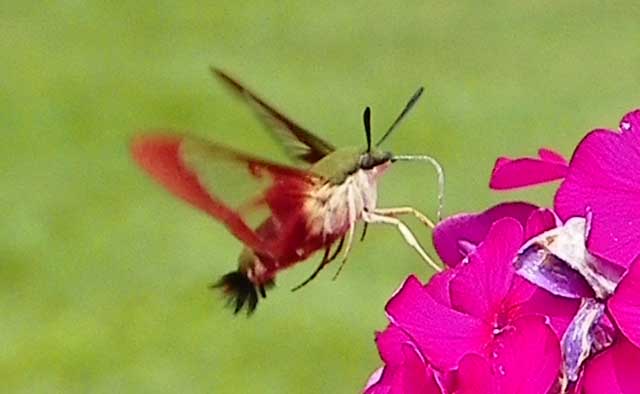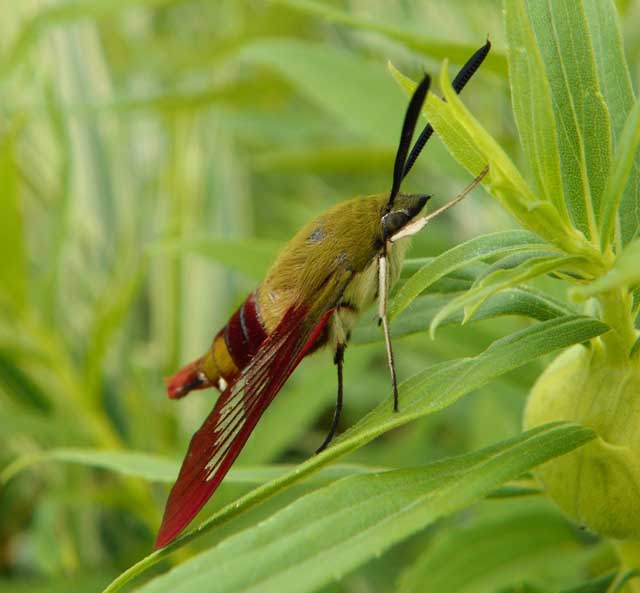Sphinginae subfamily
Sphingini tribe:
 |
Agrius cingulata,
Pink-spotted Hawkmoth
WO??, unlikely stray.
This species is a strong migrant and adults nectar from deep-throated
flowers including moonflower (Calonyction aculeatum),
morning glory (Convolvulus), honey suckle (Lonicera)
and petunia (Petunia species).
|
 |
Ceratomia amyntor,
the Elm Sphinx or Four-horned Sphinx,
WO
The upperside of the forewing is brown with dark brown and white markings including a white costal area near the wing base, dark streaks along the veins, and a white spot in the cell.
|
 |
The upperside of the forewing is pale brownish gray with wavy black
and white lines and a black-outlined white cell spot. The upperside of the hindwing is gray with diffuse darker bands.
|
 |
The upperside of the forewing is dark brown with a dusting of white
scales. Some moths have patches of reddish or yellowish brown on the
wings. doubtful
|
 |
The upperside of the forewing is gray with heavy black bands. The upperside of the hindwing is brownish gray with no markings If you have pines, you
probably have this species. It flies on P.E.I.
|
 |
The upperside of the forewing is gray-brown with wavy lines, black
dashes, and one or two small white spots near the center of the costa.
|
 |
Manduca quinquemaculatus,
the Five-spotted Hawkmoth,
WO
The moth abdomen usually has five but sometimes six pairs of yellow
bands. The upperside of the forewing is blurry brown and gray.
I suspect if you grow tomatoes, you are likely to encounter it.
|
 |
Manduca sexta, the Carolina Sphinx,
WO
The abdomen usually has six pairs of yellow bands, broken across the back. The sixth set of markings is quite small.
The upperside of the forewing has indistinct black, brown, and
white markings.
If you grow tomatoes, however, you may have encountered it as it has
been found in western N.Y.
|

|
Sphinx canadensis,
Sphinx canadensis, the Canadian Sphinx,
WO,
is not common, and is not
often reported anywhere.
Larval hosts are white ash (Fraxinus americana) and blueberry
(Vaccinium).
|
 |
Sphinx chersis, the Northern Ash Sphinx or Great Ash Sphinx,
WO.
The upperside of the forewing is soft dark gray to blue-gray with a series of black dashes, one of which reaches the wing tip.
Larval hosts are ash, lilac, privet, cherry, and quaking
aspen.
|
 |
Forewings, long and slender, are held close to the body when the moth is at rest. We have them on P.E.I., but I do not see them nearly as frequently as I see
the other Sphingidae.
|
 |
The lower forewings are predominantly brownish-yellow with a fairly
wide dark bar along the inner margin. At rest the wings hug the body,
giving the moth a long slender look.
|
 |
Sphinx luscitiosa ,
WO,
the Canadian Sphinx or
Clemen's Sphinx The upperside of the forewing is yellowish gray in males and pale gray with a faint yellow tint in females. It seems to be an uncommon species.
possibility
|
 |
If you have blueberries in the woods, then you probably have the Poecila Sphinx. They are pretty common here on Prince Edward Island, but don't fly too
far south of Massachusetts, being replaced by Sphinx gordius in Connecticut.
|
Smerinthini Tribe:
 |
The adults are also highly variable; sometimes wings of an individual may be all one color or may have several colors, ranging from pale to dark brown, and may
have a white or pink tinge.
See the file for the female; she is different. |
 |
Pachysphinx modesta,
the Modest Sphinx or Poplar Sphinx,
WO
This moth has a large, heavy body, and females can be remarkably plump.
Larvae are fond of poplars and
willows.
They are common on Prince Edward Island.
|
 |
Paonias excaecata, Blinded Sphinx,
WO: Fw outer margin quite wavy. Dark cell spot and dark oblique
line mid wing from costa almost to inner margin.
Basic ground colour is pinkish brown.
The moth gets its name from the blue-gray pupil surrounded by black, with hot pink wing scales in hindwing basal area.
|
 |
Paonias myops, the Small-eyed Sphinx,
WO:
Named for the small eye-spot in the hindwing, this moth has a wide
distribution and is probably common in your area.
I regularly see them on Prince Edward Island, and they are reported as far south as Florida and much to the west.
|
 |
Smerinthus cerisyi,
the Cerisyi's Sphinx,
WO:
Similar to jamaicensis, but jamaicensis is smaller with larger blue patches on more vibrant, deeper
purple in lower wings. Also note complete (i.e. outer margin to outer margin) off-white arc just below fw apex.
In cerisyi, lower portion of arc does not return to outer margin.
|
 |
Smerinthus jamaicensis,
the Twin-spotted Sphinx,
WO:
Closely resembles S. cerisyi, but jamaicensis is much smaller with larger blue patches on more vibrant, deeper purple in
lower wings. Also note complete (i.e. outer margin to outer margin) off-white arc just below fw apex.
|
Macroglossinae subfamily
Dilophonotini tribe:
See Hemaris comparison to help distinguish
the next three species.
 |
Hemaris thysbe, the Hummingbird Clearwing,
AM/BAMONA:
It is not difficult to see why many gardeners would mistake an
Hemaris thysbe moth for a small hummingbird as it hovers,
sipping nectar from flowers through a long feeding tube.
|
Hemaris thysbe, Groveland, July 18, 2011, Amy Marnon.
Hemaris thysbe, Lakeville, July 27, 2013, Amy Marson.
 |
Hemaris diffinis, the
Snowberry Clearwing or Bumblebee Moth,
WO
Adults mimic bumblebees and are quite variable. The wings are
basically clear, with dark brown to brownish-orange veins, bases
and edges. The thorax is golden-brown to dark greenish-brown with
1-2 yellow segments on the abdomen.
|
 |
Hemaris gracilis, the
Slender Clearwing or Graceful Clearwing,
WO:
Hemaris gracilis is distinguished from similar species by a pair of red-brown bands on the undersides of the thorax,
which varies from green to yellow-green dorsally and sometimes brown with white underneath.
|
Philampelini tribe:
 |
Eumorpha achemon,
the Achemon Sphinx,
WO:
Fw light grey and brown with many lines, Dark patches near the middle of the inner margin, near the apex and near the anal angle.
The entire basal area of the hindwing is pink.
Note the differences between this moth and the Pandorus Sphinx.
|
 |
Eumorpha pandorus, the Pandorus Sphinx,
BAMONA:
Upperside: light brown with shades of olive green to green. Fw has pink streaks along vein ends and near inner margin,
and dark squarish mark at middle of inner margin. Area from base to squarish mark is dark green.
|
Macroglossini tribe:
 |
This day flier is widely distributed. If you have Virginia Creeper, you probably have the Nessus Sphinx.
Two bright, distinct, narrow yellow bands are often visible on the abdomen.
|
 |
They are common in New Jersey and common
here on Prince Edward Island.
You will often see this species listed as Darapsa pholus,
especially in older literature.
The lower wings of this hawkmoth are a solid brownish-orange, matching the body colour.
|
 |
Darapsa myron, the Virginia Creeper Sphinx or the Grapevine Sphinx,
WO:
Fw dark brown to pale yellowish gray, often with strong greenish tint.
On the costal margin there is a dark rectangular patch, although this may be reduced or absent. Hw upperside: pale orange.
|
 |
Darapsa versicolor,
Hydrangea Sphinx, WO:
If you have hydrangea growing near a stream, then you may have the
Hydrangea Sphinx. Fw upperside: often greenish brown with curved dark lines and pinkish-white patches.
Hw upperside: pale yellow to reddish brown with white along costal margin, greenish brown along outer margin,
and white shaded with greenish brown on inner margin.
|
 |
Deidamia inscriptum,
the Lettered Sphinx,
WO: Moth's outer margin of the forewing is deeply scalloped.
The upperside is light brown with dark brown markings.
There is a small black and white spot near the tip.
The upperside of the hindwing is orange-brown with a dark brown outer margin and median line.
|
 |
Hyles gallii, the Bedstraw Hawk Moth,
or Gallium Sphinx,
AM
The forewing is dark brown with a slightly irregular cream-coloured transverse line. The outer margin is grey.
There is a bright pink band on the hindwing.
|
Hyles gallii fifth instar, Dansville, September 24, 2011, Amy Marnon.
 |
Hyles lineata, the White-lined Sphinx,
WO:
Fw is dark olive brown with paler brown along costa and outer margin, a narrow tan band running from wing tip to base, and white streaks along veins.
Hw upperside is black with a reddish pink median band.
|
 |
This moth is very much under reported across the United States. It
is a rapid day flier so is probably not in too many collections.
Grape is a popular larval host.
|
|
|




